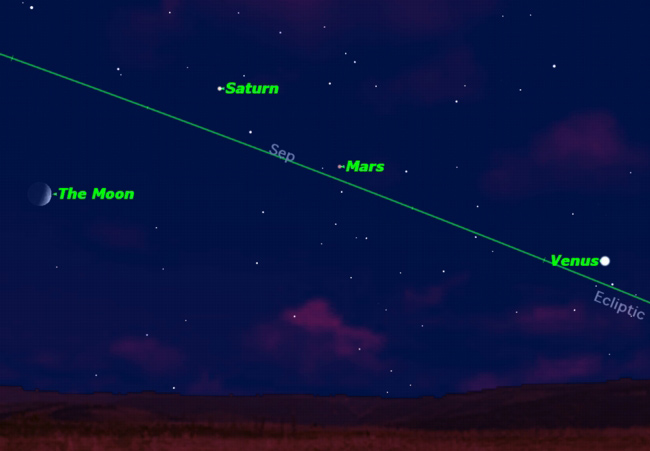Crescent Moon and 3 Bright Planets Gather This Week

Three of thebrightest planets, Venus, Mars, and Saturn, are gathering in thewestern skyjust after sunset. This week, the slender crescent moon pays eachplanet avisit in turn.
On Wednesdaynight, July 14, the moon will be directly below the brilliant planetVenus. Ifyou look at Venusthrough a telescope, you may be surprised to see that itlooks like a fatgibbous moon, 65 percent illuminated, while the moon is a slendercrescent just15 percent illuminated. How can this be?
It isbecause Venus is on the far side of the sun, so that it is ?front-lit?whereasthe moon is between us and the sun, so is ?back-lit.? Think of the fourobjectsforming a ragged line: Earth, moon, sun, Venus, with the sun somewhatoff tothe right.
But themoon's encounter with Venus is the just the beginning of its planetarytourthis week. (This graphic shows how to see the moonas it visits Venus,Mars and Saturn).
By Thursdaynight, the moon will have moved in its orbit around the Earth so thatit isdirectly below Mars, which should look distinctly orange-red to thenaked eye.Mars, too, is on the far side of the sun, and very tiny in even the mostpowerful telescope.
Finally, onFriday night, the moon will have moved to the position shown in theimage, tothe lower left of Saturn. Saturn has been a disappointment this year totelescopic observers because its famous ring system has been almostedge on toour view, and so almost invisible.
Notice howthe moon is significantly below the ecliptic, thepath taken by the sunin its apparent travel through the sky, while all three planets aresignificantly above the ecliptic.
Get the Space.com Newsletter
Breaking space news, the latest updates on rocket launches, skywatching events and more!
This is apowerful demonstration of how the moon and planets do not all travel inthesame plane. Their orbits are all slightly tilted relative to oneanother.
The orbitof the moon is tilted more than those of the planets, whichexplains why itlies so low relative to the ecliptic, and why it so rarely passesdirectly infront of any of the planets.
Although youmay not notice it over the next few nights, the three planets arethemselvesdrawing closer together, heading towards a triple conjunction in thefirst weekof August.
- Gallery? Total Solar Eclipse of 2010
- Telescopesfor Beginners
- MoreNight SkyFeatures from Starry Night Education
Thisarticle was provided to SPACE.com by Starry NightEducation, theleader in space science curriculum solutions.
Join our Space Forums to keep talking space on the latest missions, night sky and more! And if you have a news tip, correction or comment, let us know at: community@space.com.

Geoff Gaherty was Space.com's Night Sky columnist and in partnership with Starry Night software and a dedicated amateur astronomer who sought to share the wonders of the night sky with the world. Based in Canada, Geoff studied mathematics and physics at McGill University and earned a Ph.D. in anthropology from the University of Toronto, all while pursuing a passion for the night sky and serving as an astronomy communicator. He credited a partial solar eclipse observed in 1946 (at age 5) and his 1957 sighting of the Comet Arend-Roland as a teenager for sparking his interest in amateur astronomy. In 2008, Geoff won the Chant Medal from the Royal Astronomical Society of Canada, an award given to a Canadian amateur astronomer in recognition of their lifetime achievements. Sadly, Geoff passed away July 7, 2016 due to complications from a kidney transplant, but his legacy continues at Starry Night.









